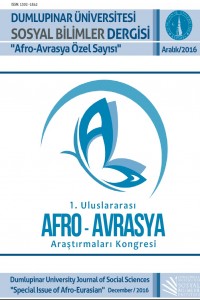Öz
This study investigates the key determinants of physical
gold demand across countries including emerging markets and developed economies
for the period of 2000-2010. A major hypothesis to be investigated is whether financial and economic volatilities stimulate consumer
demand for gold. The hypothesis is extended to examine the effects of these volatilities on gold consumption
in developing
and developed countries. The analysis here explores how consumers in emerging economies and developed countries vary in their
perception of gold. Findings suggest that gold demand is driven by different
determinants in emerging countries and developed economies. In general,
volatile economic environment stimulates gold demand in developing countries
indicating that consumers tend to purchase gold for precautionary motives.
There is a negative relation between income per capita volatility and physical
gold demand in developed economies implying that consumer in developed
countries purchases gold as jewelry instead of a hedging instrument. Finally,
results suggest that there is no significant change in gold demand after 2007
financial crises. However, there exists a notable shift in consumption of gold
categories. People tend to consume less jewelry than ever, but they prefer to
engage with more retail investment gold purchases. Incorporating proxies for
socio-cultural factors will contribute better results for future research.
Anahtar Kelimeler
Kaynakça
- Batchelor, R., & Gulley, D. (1995). Jewellery demand and the price of gold. Resources Policy, 21(1), 37-42.
- Capie, F., Mills, T. C., & Wood, G. (2005). Gold as a hedge against the dollar. Journal of International Financial Markets, Institutions and Money, 15(4), 343-352.
- Chua, J., & Woodward, R. S. (1982). Gold as an inflation hedge: a comparative study of six major industrial countries. Journal of Business Finance & Accounting, 9(2), 191-197.
- Ghosh, D. P., Levin, E. J., Macmillan, P., & Wright, R. E. 2004, Gold as an Inflation Hedge. Studies in Economics and Finance, 22(1), 1-25.
- Haugom, H. N. (1991), ‘The Supply and Demand for Gold’, Ph.D. dissertation (Simon Fraser University).
- Kannan, R. and Dhal, S. (2008), ‘India’s Demand for Gold: Some Issues for Economic Development and Macroeconomic Policy’, Indian Journal of Economics & Business, Vol. 7, No.1, (2008) : 107-128
- Ranson, D., & Wainright, H. C. (2005). Why gold, not oil, is the superior predictor of inflation. Gold Report, World Gold Council, November.
- Starr, M., & Tran, K. (2008). Determinants of the physical demand for gold: Evidence from panel data. The World Economy, 31(3), 416-436.
- Vaidyanathan, A. (1999). Consumption of Gold in India: Trends and Determinants. Economic and Political Weekly, 471-476.
GELİŞMEKTE OLAN VE GELİŞMİŞ ÜLKELERDEKİ FİZİKSEL ALTIN TALEBİ BELİRLEYİCİLERİ ÜZERİNE BİR İNCELEME, 2000-2010
Öz
Bu çalışma gelişmekte olan ve gelişmiş
ülkelerdeki fiziksel altın talebinin önemli belirleyicilerini 2000 ve 2010
yılları arasında incelemektedir. Finansal ve ekonomik belirsizlik tüketici
altın talebini teşvik edip etmediği başlıca sorgulanan hipotezlerden biri
olmakla beraber hipotez bu belirsizliklerin gelişmiş ve gelişmekte olan ülke
tüketicilerini nasıl etkilediği yönüyle de incelenmiştir. Yapılan analizlerde
her iki ülke grubundaki tüketicilerin altın algısı üzerindeki farklılıklar
ortaya çıkartılmıştır. Bulgular, altın talebinin gelişmiş ve gelişmekte olan
ülkelerdeki tüketicilerin farklı belirleyiciler tarafından açıklandığını
göstermektedir. Genel itibariyle belirsiz ekonomik ortamların gelişmekte olan
ülkelerde altın talebini arttırdığı dolayısıyla tüketicilerin ihtiyat amaçlı
altın alımı yaptıkları sonucuna varılmıştır. Bununla beraber gelişmiş ülke
tüketicilerinin altını ihtiyat amaçlı yatırımdan ziyade takı ve mücevherat
maksatlı talep ettiği ve bu ülkelerdeki kişi başına düşen gelirdeki belirsizlikle
altın talebi arasında zıt yönlü bir ilişkinin olduğu tespit edilmiştir. Son
olarak 2007 küresel finansal krizinin fiziksel altın talebini önemli ölçüde
etkilememesine rağmen insanların takıdan daha çok yatırım amaçlı altın
tüketimine yöneldiği gözlemlenmiştir. Sosyo-kültürel faktörlerin gelecek
araştırmalara eklenmesi daha iyi bulgular edinilmesine katkıda
bulunacaktır.
Anahtar Kelimeler
Kaynakça
- Batchelor, R., & Gulley, D. (1995). Jewellery demand and the price of gold. Resources Policy, 21(1), 37-42.
- Capie, F., Mills, T. C., & Wood, G. (2005). Gold as a hedge against the dollar. Journal of International Financial Markets, Institutions and Money, 15(4), 343-352.
- Chua, J., & Woodward, R. S. (1982). Gold as an inflation hedge: a comparative study of six major industrial countries. Journal of Business Finance & Accounting, 9(2), 191-197.
- Ghosh, D. P., Levin, E. J., Macmillan, P., & Wright, R. E. 2004, Gold as an Inflation Hedge. Studies in Economics and Finance, 22(1), 1-25.
- Haugom, H. N. (1991), ‘The Supply and Demand for Gold’, Ph.D. dissertation (Simon Fraser University).
- Kannan, R. and Dhal, S. (2008), ‘India’s Demand for Gold: Some Issues for Economic Development and Macroeconomic Policy’, Indian Journal of Economics & Business, Vol. 7, No.1, (2008) : 107-128
- Ranson, D., & Wainright, H. C. (2005). Why gold, not oil, is the superior predictor of inflation. Gold Report, World Gold Council, November.
- Starr, M., & Tran, K. (2008). Determinants of the physical demand for gold: Evidence from panel data. The World Economy, 31(3), 416-436.
- Vaidyanathan, A. (1999). Consumption of Gold in India: Trends and Determinants. Economic and Political Weekly, 471-476.
Ayrıntılar
| Bölüm | Makaleler |
|---|---|
| Yazarlar | |
| Yayımlanma Tarihi | 26 Aralık 2016 |
| Yayımlandığı Sayı | Yıl 2016 Afro-Avrasya Özel Sayısı |
Kaynak Göster
Dergimiz EBSCOhost, ULAKBİM/Sosyal Bilimler Veri Tabanında, SOBİAD ve Türk Eğitim İndeksi'nde yer alan uluslararası hakemli bir dergidir.


